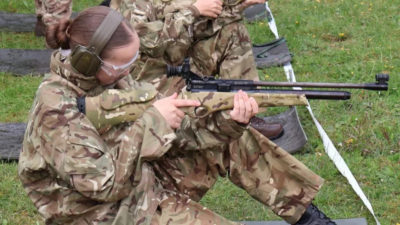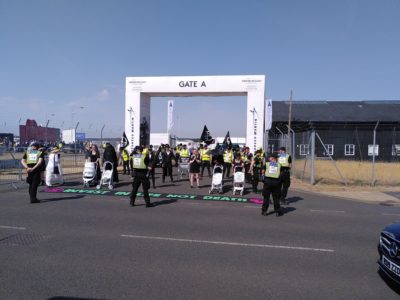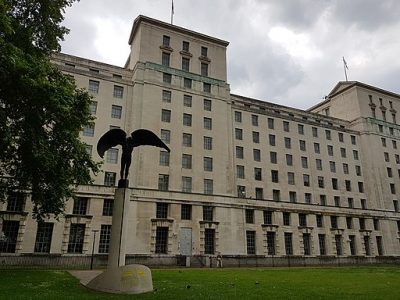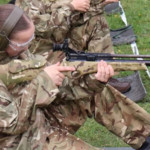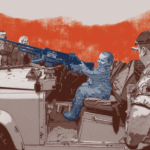Training school pupils for the military and surveillance?
ForcesWatch comment
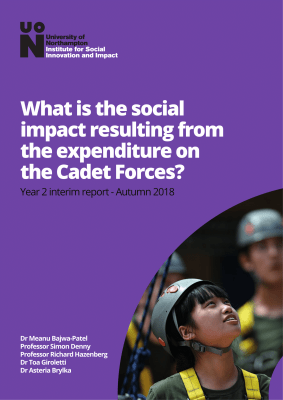
Over the last two weeks the MoD has made various announcements relating to armed forces cadets. These include 30 new cadet units in schools, referring to a new social impact report, and the extension of the Cadet Expansion Programme with cadet numbers in schools rising to 60,000 by 2024. They also unveiled a new Cyber Cadet scheme and a National Cadet Week.
Previous high profile announcements have surrounded this part of the ‘military ethos’ programme, indicating the status that the government are giving it. The driving factors are an ideological belief in the power of cadets, and the military, to transform young people’s lives, and the need to generate new recruits in the midst of a recruitment crisis. Given Gavin Williamson’s penchant for taking things further than other defence secretaries, this raft of new measures is not surprising.
As our partner organisation Quakers in Britain note, advice given to ministers in how to deal with press questions at the Conservative party conference shows the government is aware of public unease about militarism in schools which ‘expose(s) children to militarism without any exploration of the morality or danger of war.’
.@GavinWilliamson: So today, I am setting a new ambition to increase the number of cadets in schools from 43,000 to 60,000 cadets. And, each year we will celebrate our cadets with a new national Cadet Week #CPC18
— CCHQ Press Office (@CCHQPress) September 30, 2018
Flawed evaluations
Weapons, drill and other military aspects of the cadet forces are not shown in the report.
To justify a policy which has seen the number of cadet units in schools rise to 472 since 2012, the government are utilising ‘independent’ research (commissioned by the MoD, Combined Cadet Force Association and CVQO) on the social impact of cadets – from the University of Northampton Institute of Social Innovation and Impact. Our critiques of the first interim report can be read here and here.
The findings presented this year are also ‘interim’ and, as with last year’s report, raise questions about both the research design and conclusions and about using it to retrospectively justify government policy.
One problem is that the researchers only look at the impact of being in the cadets, with no attempt to make a comparative assessment with other youth activities, although this is promised in the next phase of the research. They state that, ‘the development of non-cognitive attributes and skills which are important for success in both education and the labour market, can make a significant difference to the lives of all young people’, but do not say why this should not apply equally to other well-funded youth organisations. There is no discussion about what is particular about the cadets, and the military framework that they are part of, that could contribute to the difference that they may make.
The researchers also seem to rely heavily on self-reporting by young people, teachers and adult volunteers in the cadet forces rather than measurable effects. Unfortunately the appendices for both interim reports are not available for a closer inspection of the research design.
These are common deficiencies in assessing the impact of youth activities, including cadet forces, as this paper from the Education Endowment Foundations discusses. Furthermore, little research data is provided in this latest social impact report to show how the very positive assertions made about cadets were drawn. The data that is presented – around attendance levels – suggests only some moderate improvements for some groups. There is little evidence that alternative explanations have been explored.
One example is the argument made round self-efficacy – ‘an individual’s belief in their ability to complete a specific task’. The researchers argue that, given the difference between the levels of self-efficacy normally evident between cohorts of students receiving free schools meals and those not, the finding that there is no difference in self-efficacy between cadets and non-cadets is an indicator that the cadets have a positive impact on self-belief. While they acknowledge that it is ‘not possible to say that this difference is only due to participation in cadets’, they do not explore that this change may be partially the result of being part of a self-selecting group with an enhanced self-efficacy in the first place or that changes may have happened over time anyway.
Benefits to whom?
The report frames the benefits of the cadets in terms of financial savings and national interest – is the expenditure (which is significant) warranted by the savings to the taxpayers and ‘lifetime productivity’? Even the possibility of a cadet unit being able to ‘prevent one exclusion’ is talked about in terms of ‘savings across many government departments’.
Is introducing a cadet force about enriching lives or is it primarily a mechanism to create more productive members of the workforce, increase national GDP and generate recruits to the armed forces? Cadet forces are a relatively cheap and easy way to get at least some results – given the MoD’s ready ability to exploit opportunities to make contact with young people for their own recruitment purposes. As was pointed out in a critique last year by Dr Brian Belton, senior lecturer at YMCA George Williams College, cadet forces are a prime example of youth work with a state agenda: ‘One ‘invests’ in youth and this means there is an expected dividend. The latter has of late been framed as potential and actual social mobility, but this is a metaphor (perhaps an euphemism) for the creation of a relatively flexible, relative skilled, relatively cheap workforce.’
Is introducing a cadet force about enriching lives or is it primarily a mechanism to create more productive members of the workforce, increase national GDP and generate recruits to the armed forces?
One claim for social impact that seems particularly stretched is that ‘the Cadet Forces are helping improve community cohesion’ in Northern Ireland and ‘could play an important role in helping maintain peace in the province’. The claims are not warranted by the evidence so far presented and again, there is no recognition that other youth organisations could have a similar impact or if, given the difficult history of Northern Ireland in relation to the British military, funding non-military activities may be more productive.
Evaluating or promoting?
The report goes some way into government territory of presenting ‘possible’ positive outcomes as concrete benefits, and then exaggerating them. The Executive Dean of the University of Northampton reports that the evidence is ‘overwhelmingly positive’ and that cadet forces ‘make a huge difference to improve school attendance, develop confidence and help young people become more successful.’ Such hyperbolic and as yet unsubstantiated statements are more about promoting the cadets than evaluating them.
Despite being about social impact, the report only considers positive impacts without even the slightest nod to ways in which a military presence in a school could affect individuals or groups in an adverse way. It also makes unsupported claims for potential impacts on whole school outcomes, including spiritual, moral, social and cultural (SMSC) development and health and wellbeing. It fails to mention where military activities could themselves be challenged on issues around morality or wellbeing, including around the ethics of military action and the risks involved in being part of the armed forces.
Using cadets to solve a recruitment crisis
The report further strays into policy territory when it suggests that CCFs (cadets units in schools) ‘could be part of the solution to the attainment gap and help improve social mobility across the UK’. This is then taken by the government as concrete evidence that ‘Cadet Forces increase social mobility and help young people’s self-belief‘.
Even expressed with hesitancy, such claims seem highly questionable when the military are the only well-funded option on offer, especially when other youth services are been cut and mental health services for young people are inadequate, as the researchers acknowledge.
Research on uniformed youth activities as a whole suggest similar results in terms of small increases in positive non-cognitive impacts on young people. However, other youth organisations are not receiving the same level of funding as military cadets, although the government recently promised some limited funding for a wider array of uniformed youth groups.
This kind of claim for social mobility is reminiscent of those made by senior military figures and politicians promoting military careers. Apart from the ethics of promoting risky careers for young people from communities where other opportunities are more limited, recent research shows that enlisting can be very detrimental to some, particularly those from more disadvantaged backgrounds.
It is no coincidence that the expansion of cadets is also being focussed in more disadvantaged communities, at the same time that some are calling for them to be used as a way of encouraging people into the armed forces. Indeed, the researchers will be exploring the ‘financial savings to the Defence budget’ in a further stage of the project. While the military has always stressed, in an unconvincing way, that the cadets are just youth organisations like any other, the link to recruitment is becoming more obvious. Why else would the MoD be funding this massive programme? Why else would the MoD be making policy about education?
With these attempts to make unique claims for the positive impact of the cadets across many areas of society, we must also ask, just how far will cadet forces be rolled out in schools?
Cyber cadets
In a typical move by the military, the MoD have taken a current social concern and found a way to weave it in with a recruitment programme. Perhaps it is not surprising that as the military focus more on cyber-crime, that they would seek to seed interest in related careers amongst young people. The Defence Secretary has announced the Cadets CyberFirst programme which will be delivered by the various MoD cadet organisations and the GCHQ National Cyber Security Centre. It will ‘equip over 2,000 cadets a year with the skills and expertise to become future leaders in this emerging industry.’
While it is important that young people learn how to protect themselves online, this scheme may primarily just be a way of harnessing young people into ‘tackling security threats’.
Available information about what activities cyber cadets will involve may not immediately ring alarm bells although the involvement of both the MoD and GCHQ suggests longer-term benefits for military and surveillance industries. While it is important that young people learn how to protect themselves online, this scheme may primarily just be a way of harnessing young people into ‘tackling security threats’. As we have seen with policies like the Investigatory Powers Act (dubbed the ‘snooper’s charter’) and Prevent, issues around surveillance and privacy are controversial and political, particularly when they intersect with institutions with a duty of care for young people. The operation of a cyber-crime agenda in schools may raise similar concerns.
Ethical debate around cyber-conflict is a complex and growing area, along with debate about new technologies and how they are applied for warfare, defence and security. If children and young people are to become actively involved in this area, along with more traditional military activities, then it is surely essential that education that explores the ethical issues around defence of all kinds becomes embedded and widespread within education.
See more: cadets, military in schools/colleges,
Like what you read?
> Sign up for our newsletter or blog notifications
> Support our work – from just £2 a month

